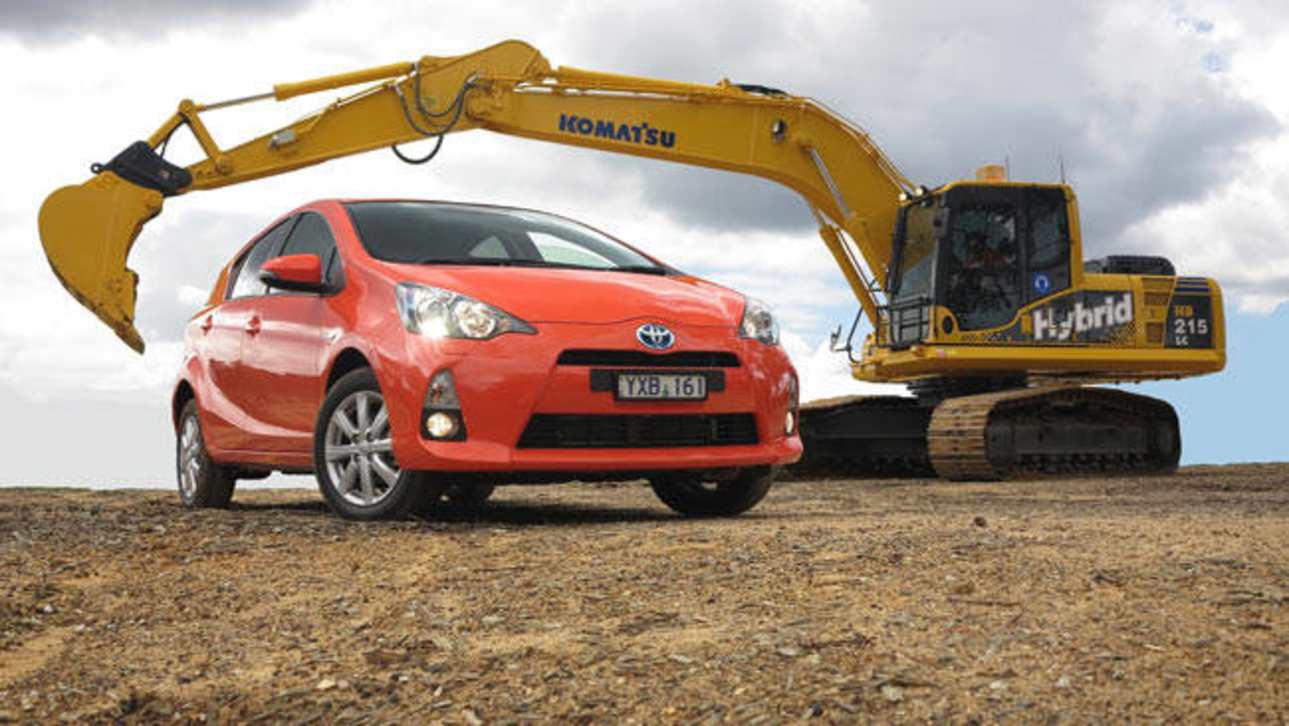Fuel-saving hybrid technology designed to save the planet is now being used to dig it up. Earthmover maker Komatsu has adopted a hybrid system to save money and fuel on worksites across the country.
Weighing a pinch over 21 tonnes it’s a far cry from the Toyota Prius C, one of Australia’s cheapest hybrid cars. It’s bright yellow arm (capable of carrying a 2450kg load) could lift two of the tiny-tot Toyotas in one deft swing -- and still have room to dig some dirt.
The Komatsu is also a tad more expensive than the Toyota. At $240,000 with a few options -- a 20 per cent premium on an equivalent non-hybrid excavator, or equal to 10 Priuses – that’s Porsche money.
And yet it has a top speed of only 5 km/h. Keeping these machines running isn’t cheap either. A new set of tracks cost $15,000, compared to about $800 for a set of four new tyres on the Toyota.
At least the Komatsu has one advantage of its technical twin: it has a tighter turning circle because it’s able to spin on its own axis, equal to the length of its tracks (3.7 metres plays the Toyota 9.6 metre turning radius).
Unlike hybrid systems in cars -- which in most cases use electric power to move a car from rest before the petrol engine takes over -- the Komatsu’s hybrid system is used only to rotate the upper body. That’s because these machines spend most of their day in one spot digging holes and dumping the rubble.
So when the body structure swivels it’s almost silent because it’s electrically powered, thanks to the energy stored in a massive onboard capacitor. And you thought hybrid cars in car parks were a silent menace.
Fancy an 830kg bucket coming your way -- at head height? When the capacitor needs to be recharged, the Komatsu’s 4.46-litre turbo diesel engine kicks in. Following a similar downsizing trend with cars, this is a four-cylinder engine when most excavators of this size have six-cylinder power.
The Komatsu hybrid’s diesel engine also operates at lower revs than regular models (1300-1400 rpm versus 1800-2000rpm) because the electric motor provides extra boost. The result is a 25 per cent saving in fuel, or more depending on use. Most machines of this size consume 21 litres of fuel per hour in heavy use or 15 litre per hour on average; the hybrid uses 11 to 15 litres per hour in the same conditions.
Having done its bit to save the planet, Komatsu bravely let me behind the wheel to allow me to leave my mark in it. I've been lucky enough to drive Ferraris, Porsches and Lamborghinis, but I was more nervous climbing -- literally -- into this. Inside, there is a large display screen which shows how much energy you’re using -- and saving -- with the same type of digital diagrams you see in hybrid cars.
The controls are fairly straightforward. The lever is similar to that of an arcade game, except out here the consequences are real, which is why there is a panic button to shut it down instantly. Scared of making a wrong move, I basically ended up with a deeper hole in the same spot. I wasn’t brave enough to break new ground. But when I eventually did get the swing of it, the machine's minders had to bang on the soundproof door to get me out. And to think people get paid to have this much fun.
This reporter is on Twitter: @JoshuaDowling
Toyota Prius C
Price: $23,990 (plus on-road costs)
Engine: 1.5-litre four-cylinder petrol with 45kW electric motor
Economy: 3.9L/100km
Fuel tank: 36 litres
Weight: 1140kg
Payload: 425kg
Turning circle: 9.6 metres
Top speed: 170km/h
Safety: Seven airbags, stability control, rear camera
Komatsu
Price: $240,000 (with options)
Engine: 4.46-litre four-cylinder turbo diesel with 35kW electric motor
Economy: 11 litres per hour
Fuel tank: 400 litres
Weight: 21,437kg
Payload: 2450kg
Turning circle: 3.7 metres
Top speed: 5.5km/h
Safety: Rear view mirror, handrails, panic button, rear camera.


.jpg)


.jpg)








.jpg)




.jpg)
Comments